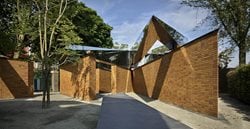
The Dutch Auschwitz Committee together with His Majesty the King of the Netherlands, opened the National Holocaust Memorial of Names (Nationaal Holocaust Namenmonument Nederland) designed by Studio Libeskind in collaboration with local partner Rijnboutt.
The memorial is the first to memorialize all the 102,000 names of the Dutch victims (Jews, Roma and Sinti) of the Holocaust.
More than 75 years after World War II, a memorial dedicated to the more than 102,000 Dutch victims of the Holocaust has been finally realized. The memorial contains the names of all Dutch Jew, Sinti and Roma Holocaust victims that have no marked grave. The Netherlands will at last have a tangible memorial to collectively honor those lost.
“For the bereaved, it is of inestimable value to have a place where they can remember their loved ones. It means that the names of Holocaust victims will not be forgotten. Moreover, the memorial forms a trait d’union between past, present and – importantly – future. Remembrance is not only for those who lived through the war but also for those who did not experience it – the children and grandchildren and following generations. In addition, the memorial raises historical awareness of where wars can lead, while also encouraging people to reflect on and learn from World War II,” explains Jacques Grishaver, chairman of the Dutch Auschwitz Committee.
Situated along the Weesperstraat, an important axis within the Jewish Cultural Quarter, the Names Memorial is adjacent to the Hermitage Museum, East of the Diaconie’s verdant Hoftuin garden and café, just a stone’s throw from the Amstel River and in close proximity to important Jewish cultural institutions such as the Jewish Historical Museum and the Portuguese Synagogue.
The 1,700 square meter memorial incorporates four volumes that represent the letters in the Hebrew word לזכר meaning “In Memory of”. The volumes are arranged in a rectilinear configuration on the north-south axis of the main thoroughfare Weesperstraat and the Hoftuin pavilion to the West.

As visitors enter the memorial they will encounter passages articulated by two meter high brick walls carrying the message of Remembrance. Each of the four volumes is crafted from mirror finished stainless steel that hovers above the walls of individually stacked bricks. 102,000 bricks will each be inscribed with a the first and last name, along with their age and birthday, giving a tangible quantification to the many casualties, as well leaving 1000 blank bricks that will memorialize the unknown victims.

“The Dutch lost the largest percentage of their Jewish population in the Holocaust. The National Holocaust Memorial of Names is the first Holocaust memorial to commemorate the Dutch victims and the first of its kind in Amsterdam,” said architect Daniel Libeskind. “My personal connection as a child of Holocaust survivors has made it increasingly important to be a part of this significant project. I hope it will become a place for contemplation, hope, and an important reminder to fight hate in all its forms for the people of the Netherlands and beyond,” added Libeskind.
The materiality of the brick—a ubiquitous material of The Netherlands and throughout the cities of Western Europe – paired with the highly reflective and geometric forms of the steel letters reference the connection between the Netherlands past and present. At the intersection of the brick and metallic forms is a narrow void that creates the illusion that the steel letters are hovering above and represents an interruption in the history and culture of the Dutch people. This suspended emptiness, or ‘Breath of Air’, detaches the neighborhood from a future in which Dutch-Jewish families went missing. The memorial will have an interactive element that will allow visitors to place stones by the names on the bricks, similar to the way one honors the dead at a grave.

Below street level, the floors around the walls are of a light stabilized gravel create a path through the four volumes. Simple stone blocks are placed in the open spaces and walkways to provide a resting place for contemplation and reflection.
Situated next to a subway station to the north and a roadway to the east, the floating polished steel volumes will be visible to commuters during all hours. Light and Reflection (self-reflection as well as reflection from the street and the city that surrounds it) are necessary for a meaningful understanding of what happened and the lives lost in the catastrophe of the Holocaust.
***
All the photos ©Kees Hummel




 17
17
comment